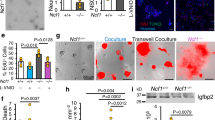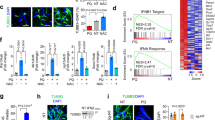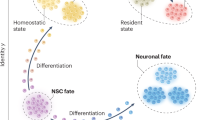Abstract
Reactive oxygen species (ROS) are conventionally classified as toxic consequences of aerobic life, and the brain is particularly susceptible to ROS-induced oxidative stress and damage owing to its high energy and oxygen demands. NADPH oxidases (Nox) are a widespread source of brain ROS implicated in seizures, stroke and neurodegeneration. A physiological role for ROS generation in normal brain function has not been established, despite the fact that mice and humans lacking functional Nox proteins have cognitive deficits. Using molecular imaging with Peroxyfluor-6 (PF6), a new selective fluorescent indicator for hydrogen peroxide (H2O2), we show that adult hippocampal stem/progenitor cells (AHPs) generate H2O2 through Nox2 to regulate intracellular growth signaling pathways, which in turn maintains their normal proliferation in vitro and in vivo. Our results challenge the traditional view that brain ROS are solely deleterious by demonstrating that controlled ROS chemistry is needed for maintaining specific cell populations.
This is a preview of subscription content, access via your institution
Access options
Subscribe to this journal
Receive 12 print issues and online access
$259.00 per year
only $21.58 per issue
Buy this article
- Purchase on Springer Link
- Instant access to full article PDF
Prices may be subject to local taxes which are calculated during checkout





Similar content being viewed by others
References
Floyd, R.A. Oxidative damage to behavior during aging. Science 254, 1597 (1991).
Harman, D. The aging process. Proc. Natl. Acad. Sci. USA 78, 7124–7128 (1981).
Andersen, J.K. Oxidative stress in neurodegeneration: cause or consequence? Nat. Med. 10, S18–S25 (2004).
Bedard, K. & Krause, K.H. The NOX family of ROS-generating NADPH oxidases: physiology and pathophysiology. Physiol. Rev. 87, 245–313 (2007).
Lambeth, J.D. NOX enzymes and the biology of reactive oxygen. Nat. Rev. Immunol. 4, 181–189 (2004).
Geiszt, M., Kopp, J.B., Várnai, P. & Leto, T.L. Identification of renox, an NAD(P)H oxidase in kidney. Proc. Natl. Acad. Sci. USA 97, 8010–8014 (2000).
Suh, Y.A. et al. Cell transformation by the superoxide-generating oxidase Mox1. Nature 401, 79–82 (1999).
Sundaresan, M., Yu, Z.X., Ferrans, V.J., Irani, K. & Finkel, T. Requirement for generation of H2O2 for platelet-derived growth factor signal transduction. Science 270, 296–299 (1995).
Rhee, S.G. H2O2, a necessary evil for cell signaling. Science 312, 1882–1883 (2006).
D'Autréaux, B. & Toledano, M.B. ROS as signalling molecules: mechanisms that generate specificity in ROS homeostasis. Nat. Rev. Mol. Cell Biol. 8, 813–824 (2007).
Poole, L.B. & Nelson, K.J. Discovering mechanisms of signaling-mediated cysteine oxidation. Curr. Opin. Chem. Biol. 12, 18–24 (2008).
Woo, H.A. et al. Inactivation of peroxiredoxin I by phosphorylation allows localized H2O2 accumulation for cell signaling. Cell 140, 517–528 (2010).
Niethammer, P., Grabher, C., Look, A.T. & Mitchison, T.J. A tissue-scale gradient of hydrogen peroxide mediates rapid wound detection in zebrafish. Nature 459, 996–999 (2009).
Paulsen, C.E. & Carroll, K.S. Orchestrating redox signaling networks through regulatory cysteine switches. ACS Chem. Biol. 5, 47–62 (2010).
Miller, E.W., Dickinson, B.C. & Chang, C.J. Aquaporin-3 mediates hydrogen peroxide uptake to regulate downstream intracellular signaling. Proc. Natl. Acad. Sci. USA 107, 15681–15686 (2010).
Walder, C.E. et al. Ischemic stroke injury is reduced in mice lacking a functional NADPH oxidase. Stroke 28, 2252–2258 (1997).
Park, L., Anrather, J., Girouard, H., Zhou, P. & Iadecola, C. Nox2-derived reactive oxygen species mediate neurovascular dysregulation in the aging mouse brain. J. Cereb. Blood Flow Metab. 27, 1908–1918 (2007).
Behrens, M.M. et al. Ketamine-induced loss of phenotype of fast-spiking interneurons is mediated by NADPH-oxidase. Science 318, 1645–1647 (2007).
Park, L. et al. Nox2-derived radicals contribute to neurovascular and behavioral dysfunction in mice overexpressing the amyloid precursor protein. Proc. Natl. Acad. Sci. USA 105, 1347–1352 (2008).
Zhang, W. et al. Neuroprotective effect of dextromethorphan in the MPTP Parkinson's disease model: role of NADPH oxidase. FASEB J. 18, 589–591 (2004).
Sorce, S. & Krause, K.H. NOX enzymes in the central nervous system: from signaling to disease. Antioxid. Redox Signal. 11, 2481–2504 (2009).
Pao, M. et al. Cognitive function in patients with Chronic Granulomatous Disease: a preliminary report. Psychosomatics 45, 230–234 (2004).
Kishida, K.T. et al. Synaptic plasticity deficits and mild memory impairments in mouse models of chronic granulomatous disease. Mol. Cell. Biol. 26, 5908–5920 (2006).
Zhao, C., Deng, W. & Gage, F.H. Mechanisms and functional implications of adult neurogenesis. Cell 132, 645–660 (2008).
Palmer, T.D., Markakis, E.A., Willhoite, A.R., Safar, F. & Gage, F.H. Fibroblast growth factor-2 activates a latent neurogenic program in neural stem cells from diverse regions of the adult CNS. J. Neurosci. 19, 8487–8497 (1999).
Winterbourn, C.C. Reconciling the chemistry and biology of reactive oxygen species. Nat. Chem. Biol. 4, 278–286 (2008).
Barnham, K.J., Masters, C.L. & Bush, A.I. Neurodegenerative diseases and oxidative stress. Nat. Rev. Drug Discov. 3, 205–214 (2004).
Miller, E.W. & Chang, C.J. Fluorescent probes for nitric oxide and hydrogen peroxide in cell signaling. Curr. Opin. Chem. Biol. 11, 620–625 (2007).
Chang, M.C.Y., Pralle, A., Isacoff, E.Y. & Chang, C.J. A selective, cell-permeable optical probe for hydrogen peroxide in living cells. J. Am. Chem. Soc. 126, 15392–15393 (2004).
Miller, E.W., Albers, A.E., Pralle, A., Isacoff, E.Y. & Chang, C.J. Boronate-based fluorescent probes for imaging cellular hydrogen peroxide. J. Am. Chem. Soc. 127, 16652–16659 (2005).
Albers, A.E., Okreglak, V.S. & Chang, C.J. A FRET-based approach to ratiometric fluorescence detection of hydrogen peroxide. J. Am. Chem. Soc. 128, 9640–9641 (2006).
Albers, A.E., Dickinson, B.C., Miller, E.W. & Chang, C.J. A red-emitting naphthofluorescein-based fluorescent probe for selective detection of hydrogen peroxide in living cells. Bioorg. Med. Chem. Lett. 18, 5948–5950 (2008).
Srikun, D., Albers, A.E., Nam, C.I., Ivarone, A.T. & Chang, C.J. Organelle-targetable fluorescent probes for imaging hydrogen peroxide in living cells via SNAP-tag protein labeling. J. Am. Chem. Soc. 132, 4455–4465 (2010).
Dickinson, B.C. & Chang, C.J. A targetable fluorescent probe for imaging hydrogen peroxide in the mitochondria of living cells. J. Am. Chem. Soc. 130, 9638–9639 (2008).
Dickinson, B.C., Srikun, D. & Chang, C.J. Mitochondrial-targeted fluorescent probes for reactive oxygen species. Curr. Opin. Chem. Biol. 14, 50–56 (2010).
Srikun, D., Miller, E.W., Domaille, D.W. & Chang, C.J. An ICT-based approach to ratiometric fluorescence imaging of hydrogen peroxide produced in living cells. J. Am. Chem. Soc. 130, 4596–4597 (2008).
Miller, E.W., Tulyathan, O., Isacoff, E.Y. & Chang, C.J. Molecular imaging of hydrogen peroxide produced for cell signaling. Nat. Chem. Biol. 3, 263–267 (2007).
Dickinson, B.C., Huynh, C. & Chang, C.J. A palette of fluorescent probes with varying emission colors for imaging hydrogen peroxide signaling in living cells. J. Am. Chem. Soc. 132, 5906–5915 (2010).
Tsien, R.Y. A non-disruptive technique for loading calcium buffers and indicators into cells. Nature 290, 527–528 (1981).
Izumi, S., Urano, Y., Hanaoka, K., Terai, T. & Nagano, T. A simple and effective strategy to increase the sensitivity of fluorescence probes in living cells. J. Am. Chem. Soc. 131, 10189–10200 (2009).
Pluth, M.D., McQuade, L.E. & Lippard, S.J. Cell-trappable fluorescent probes for nitric oxide visualization in living cells. Org. Lett. 12, 2318–2321 (2010).
McQuade, L.E. & Lippard, S.J. Cell-trappable quinoline-derivatized fluoresceins for selective and reversible biological Zn(ii) detection. Inorg. Chem. 49, 9535–9545 (2010).
McQuade, L.E. et al. Visualization of nitric oxide production in the mouse main olfactory bulb by a cell-trappable copper(II) fluorescent probe. Proc. Natl. Acad. Sci. USA 107, 8525–8530 (2010).
Hempel, S.L., Buettner, G.R., O′Malley, Y.Q., Wessels, D.A. & Flaherty, D.M. Dihydrofluorescein diacetate is superior for detecting intracellular oxidants: comparison with 2′,7′-dichlorodihydrofluorescein diacetate, 5(and 6)-carboxy-2′,7′-dichlorodihydrofluorescein diacetate, and dihydrorhodamine 123. Free Radic. Biol. Med. 27, 146–159 (1999).
Robinson, K.M. et al. Selective fluorescent imaging of superoxide in vivo using ethidium-based probes. Proc. Natl. Acad. Sci. USA 103, 15038–15043 (2006).
Prozorovski, T. et al. Sirt1 contributes critically to the redox-dependent fate of neural progenitors. Nat. Cell Biol. 10, 385–394 (2008).
Kwon, J. et al. Reversible oxidation and inactivation of the tumor suppressor PTEN in cells stimulated with peptide growth factors. Proc. Natl. Acad. Sci. USA 101, 16419–16424 (2004).
Peltier, J., O′Neill, A. & Schaffer, D.V. PI3K/Akt and CREB regulate adult neural hippocampal progenitor proliferation and differentiation. Dev. Neurobiol. 67, 1348–1361 (2007).
Lee, S.R. et al. Reversible inactivation of the tumor suppressor PTEN by H2O2. J. Biol. Chem. 277, 20336–20342 (2002).
Suh, H. et al. In vivo fate analysis reveals the multipotent and self-renewal capacities of Sox2+ neural stem cells in the adult hippocampus. Cell Stem Cell 1, 515–528 (2007).
Acknowledgements
We thank the Packard and Sloan Foundations (C.J.C.), the UC Berkeley Hellman Faculty Fund (C.J.C.), Amgen, Astra Zeneca and Novartis (C.J.C.) and the US National Institutes of Health (GM 79465 to C.J.C. and EB 007295 to D.V.S.) for providing funding for this work. C.J.C. is an Investigator with the Howard Hughes Medical Institute. B.C.D. was partially supported by a Chemical Biology Training Grant from the US National Institutes of Health. (T32 GM066698). J.P. was partially supported by a training grant fellowship from the California Institute for Regenerative Medicine (T1-00007). We thank M. Quinn (Montana State University) for generous donation of Nox2 antibodies and T. Kawahara for helpful advice.
Author information
Authors and Affiliations
Contributions
B.C.D. synthesized all compounds in the paper and performed all analytical measurements, imaging assays and cell culture and mouse experiments. J.P. collaborated on cell culture, RT-PCR and mouse experiments. D.S. helped with mouse experiments. C.J.C., D.V.S., B.C.D. and J.P. designed experimental strategies. C.J.C. and B.C.D. wrote the paper with input from all coauthors.
Corresponding authors
Ethics declarations
Competing interests
The authors declare no competing financial interests.
Supplementary information
Supplementary Text and Figures
Supplementary Methods and Supplementary Figures 1–9 (PDF 1428 kb)
Rights and permissions
About this article
Cite this article
Dickinson, B., Peltier, J., Stone, D. et al. Nox2 redox signaling maintains essential cell populations in the brain. Nat Chem Biol 7, 106–112 (2011). https://doi.org/10.1038/nchembio.497
Received:
Accepted:
Published:
Issue Date:
DOI: https://doi.org/10.1038/nchembio.497
This article is cited by
-
Redox-dependent Igfbp2 signaling controls Brca1 DNA damage response to govern neural stem cell fate
Nature Communications (2023)
-
Hydrogen peroxide induced by nerve injury promotes axon regeneration via connective tissue growth factor
Acta Neuropathologica Communications (2022)
-
A puromycin-dependent activity-based sensing probe for histochemical staining of hydrogen peroxide in cells and animal tissues
Nature Protocols (2022)
-
High intraluminal pressure promotes vascular inflammation via caveolin-1
Scientific Reports (2021)
-
Cerebrospinal fluid proteome shows disrupted neuronal development in multiple sclerosis
Scientific Reports (2021)



